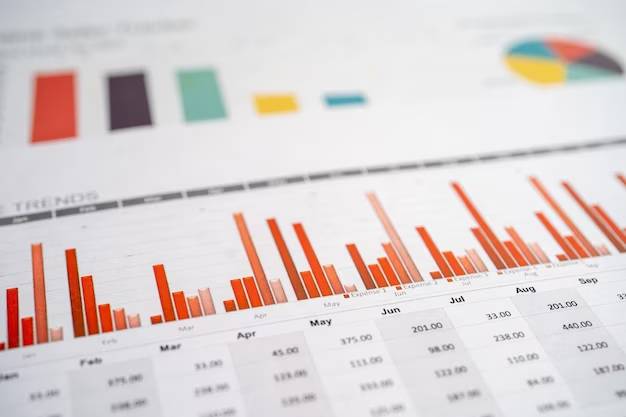Stock Demand Forecasting with ERP System in Wholesale Trading
Imagine this scenario - You are running a wholesale trading business that supplies products with a wide range of variants to customers across Malaysia. In such a highly competitive market in Malaysia, the key to success lies in having efficient inventory management techniques.
You need to be prepared for seasonal fluctuations, potential returns, and timely replenishment of your stock. And, this is where demand forecasting comes into play.
By the time you finish reading this blog, you will have a clear understanding of demand forecasting, the advantages it brings to stock management, the growing importance of demand forecasting for business in 2023, how to perform demand forecasting with ERP systems, and which ERP is the right solution for your business.
So, let’s get started!
What Is Stock Demand Forecasting?
Stock demand forecasting (also known as stock demand planning) is a part of the business process using historical sales data, current market trends, and upcoming promotions to estimate the required inventories for a future period.
Demand forecasting is essential for businesses across all sectors, especially businesses engaged in wholesale distribution to make smart purchase decisions and plan inventory based on data.
With that, your warehouses will have enough products to fulfill customers' orders from time to time which ultimately improves customer satisfaction greatly.
Real-life Examples of Demand Forecasting In Wholesale Business
There are countless examples of demand forecasting in action in wholesale companies. Let’s take a look at five real-life scenarios:

- Picture this: a furniture store is preparing for its seasonal sale, and they want to make sure they have enough of its popular living room sets in stock to meet customer demand. So, they turn to their trusty ERP system to help them predict how many sets they will need by analyzing custom sales reports.

- Now let’s talk bananas. A grocery store wants to make sure they always have enough fresh bananas on their shelves, but they don’t want to order more than they need and risk waste. With an ERP system, they can predict how many pounds of bananas they will need each week by looking at sales data and market trends, ensuring their customers always get the freshest bananas.

- An apparel retailer has a lot of different products to manage, from shoes to hats to bags. By using demand forecasting with an ERP system, they can anticipate how much demand there will be for each product and optimize their inventory levels to avoid overstocking or running out of stock. That means their customers will always get the products they want and when they want them.

- An electronics retailer has to keep up with constantly changing technology and shifting consumer preferences. With demand forecasting using ERP systems, they understand which electronics products will be most popular and optimize their inventory levels and pricing accordingly. That way, they can make sure their customers are always happy with their product selection and pricing.

- Car dealerships need to make sure they are ordering the right number of each car model to ensure effective cash flow. With an ERP system, they can use custom sales reports to predict the most profitable car models and variants and make sure they have enough inventory on hand to meet customer demand. This means they can keep their customers happy while also optimizing their business operations.
6 Benefits of Stock Demand Forecasting For Wholesale Distribution Businesses
If you are engaged in the hardware distribution business, you should know how stock demand forecasting helps you. Here you go.
Efficient inventory management
Reduce inventory costs
Improve sales and revenue
Efficient supply chain operation
Improve customer satisfaction
Preparing your budget
Efficient Inventory Management
Good inventory management is about making sure you have enough products ready to meet what customers want without excessive stockpiling.
What is the key? Accurate stock demand forecasting.
Accurate stock demand forecasting helps you keep your inventory in check.
You can figure out what products will be in high demand and when, so you can control your inventory smartly.
With that, you don't end up with too much stock that goes bad or unsellable because the market shifted.
At the same time, accurate demand forecasting avoids the pitfall of having too little, so customers can always get what they want, when they want.
Reduce Inventory Costs
Overstocking can seriously drive up your inventory costs.
But, when you have accurate stock demand forecasting, you will make smart purchase decisions.
You know what is not necessary to buy. While also keeping those hot-selling items at optimal quantities - no more excessive orders.
This strategy cut down the need for extra storage space and reduces product waste associated with costly expenses.
Improve Sales and Revenue
Effective demand forecasting means more sales and revenue.
When demand forecasting is on point, you can sync up sales and marketing strategies because your inventory data tells you what customers are craving.
By getting production schedules also in sync, you can rest assured your warehouse have enough hot stuff that keeps customers smiling and coming back for more.
Results? Happy customer. And. More sales, more cash.
Efficient Supply Chain Operation
Having a smooth supply chain is like a breeze when you know not just how much you will sell, but when it's likely to happen.
That is where accurate demand forecasting steps in.
Demand forecasting helps you predict those surges in customer demand ahead of time, which lets you plan out the operation of the supply chains - production, warehousing, and shipping with ease.
As a result, no more last-minute rushes in production or orders on hold!
Improve Customer Satisfaction
Making your customers happy is easy when you consistently provide them with great products, just the right amount, and right time.
By using demand forecasting, you can always have enough of the popular products in stock, avoiding any shortages during peak season.
And, this means fewer delays for customers, making their shopping experience smoother.
When you consistently meet customer demands, they will be happier, and your wholesale business will gain a reputation for being trustworthy and reliable.
Preparing Your Budget
Budget planning becomes a lot easier when you can forecast demand accurately.
Overestimating the needed inventory leads to the unnecessary tying up of funds that could be better utilized for new product lines or marketing campaigns.
Through stock demand forecasting, wholesalers can foresee high-demand periods, distribute resources and allocate budget accordingly.
This way, financial strain during peak demand season is all prevented while nurturing consistent financial stability year-round.
Why Demand Forecasting Is Necessary In Wholesale Companies?
Demand forecasting with an ERP system becomes particularly important in times of uncertainty or change.
It helps businesses to make better decisions about inventory, production, and pricing strategies.
Let’s take a look at some examples of such circumstances where demand forecasting plays a crucial role.
Pandemic
Supply chain disruptions
Price fluctuations
Seasonal changes
New product launches
 Pandemic
Pandemic
During a pandemic, like the current COVID-19 crisis, consumer behavior can shift unpredictably.
Demand for certain products may rise sharply while demand for others may drop. For example, during the pandemic, there was a surge in demand for home fitness equipment.
Companies that accurately forecasted this demand were able to meet the growing needs of consumers and capitalize on the opportunity.
 Price fluctuations
Price fluctuations
Price fluctuations in raw materials or labor can also have a ripple effect on the entire supply chain.
If the cost of a particular product increases, consumers may switch to a cheaper alternative or reduce their purchase.
Demand forecasting can help companies cope with these fluctuations and adjust their pricing to prevent inventory buildup or shortage.
 Seasonal changes
Seasonal changes
Demand for certain products can vary widely depending on the time of year.
For instance, demand for winter coats is higher in winter months, while demand for swimsuits is higher during summer.
Accurate demand forecasting can help companies plan ahead and stock up on seasonal items in advance, avoiding costly overstock or shortages. This allows you to effectively meet seasonal demand and maximize revenue.
 New product launches
New product launches
When a company launches a new product or enters a new market, it's crucial to forecast demand accurately to ensure that the product does not face inventory shortages.
Companies that can effectively forecast demand for new products are better positioned to plan for production and distribution.
So, trading companies can always have enough inventory to meet demand, increasing sales and customer satisfaction.
 Supply chain disruptions
Supply chain disruptions
Supply chain disruptions can impact consumer demand in unexpected ways.
For example, if a supplier fails to deliver a critical component, it may result in a shortage of finished products, leading to decreased demand.
Businesses that can quickly respond to supply chain disruptions and adapt their demand forecasting are able to minimize the impact of disruptions and consistently deliver to customers on time.
Stock Demand Forecasting with ERP Systems
An ERP (Enterprise Resource Planning) system is a powerful tool that can help you accurately forecast demand for your wholesale distribution business.
In ERP system, you can bring all your data together.
And bam!
You get a complete picture of your business. This means you can make better, smarter decisions for your inventory management that will help you grow.
Here’s what you could do with ERP systems for accurate stock demand forecasting:
Set Reordering Rules
Analyze Stock Forecast Report
Create Custom Report
Define Lead Time
Get Inventory Valuation
 Set Reordering Rules
Set Reordering Rules
Let’s say you own a retail store that sells clothing, and you notice that a certain shirt design is selling like hotcakes.
To make sure you always have enough stock on hand, use ERP system to set reordering rules.
Reordering rules tell the system to automatically replenish your shirt when it falls below minimum levels, so you never run out of the shirt in question.
 Analyze Stock Forecast Report
Analyze Stock Forecast Report
Stock forecast report estimates the stock levels for each shirt design based on current stock on-hand and incoming/outgoing stock.
So you plan better for your inventory and warehouse management, knowing what and when to restock without causing overstocking that costs you more than extra.
 Create Custom Report
Create Custom Report
You can also generate a custom report in the ERP system based on the information you want to see.
For instance, you generate a report to compare customer segments with product sales to understand which products are more popular within a specific customer group.
This way, you can effectively focus your marketing campaigns on the right products, targeting your audience more precisely.
 Define Lead Time
Define Lead Time
By accurately setting the lead time, you can gain a clear understanding of the time required to process an order, from order placement to order delivery to the customer.
For example, if a product has a lead time of two weeks, it necessitates stocking an amount that can cater to the demand over that period.
This helps you optimize inventory levels, reducing the risks of stockouts or overstock. This, in turn, enhances the management of the entire supply chain.
 Inventory Valuation
Inventory Valuation
Inventory valuation contributes to improved demand forecasting in a simple way.
Through inventory valuation, you know how much your inventory is worth. At the same time, you can decide what to do with the items that are not selling well.
This means you can plan better for what products to order next in what quantities, leading to consistent fulfillment of customer demands.
Why Choose Odoo For Demand Forecasting?
If you’re looking for an ERP system that can help you accurately forecast demand and optimize your inventory and supply chain management, Odoo is the way to go!
One of the coolest things about Odoo is its dashboard and reporting tools. Not only they are super powerful, but they’re also designed to be super easy to use, even if you’re not an ERP expert. And, let’s be honest, who really is an ERP expert anyway?
But wait, there’s more! Odoo’s dashboard and reporting tools look really nice with their clean and modern design. You can easily spot trends and patterns in your data through various graphical illustrations. Trust me, nothing makes you feel smarter than being able to identify trends like a pro!
With Odoo, you can keep a close eye on your KPIs, like sales, inventory levels, business revenue, and customer demand. This means you can make informed decisions based on real-time changes in the market, not just guesswork.
But what’s really great about Odoo is its flexibility. You can customize your dashboards and reports to focus on the metrics that matter most to you. And let’s face it, as a trading company, you probably have some unique reporting requirements based on your products and markets.
So, if you want to make data-driven decisions for your business from today onwards, give Odoo a try! You won’t regret it!
Wrap Up
No matter what you are selling, accurate demand forecasting is crucial for any wholesale distribution business to thrive in the competitive Malaysian market.
And to achieve this, a comprehensive ERP system like Odoo should be your choice.
Odoo gives you user-friendly dashboards and reporting tools that give reliable insights and don’t overcomplicate things.
With current circumstances like supply chain disruptions, pandemics, price fluctuations, seasonal changes, and new product launches, demand forecasting has become a necessary strategy rather than an option.
With the help of an ERP system like Odoo, businesses can optimize inventory levels and warehouse management for better outcomes.
So if you are looking to keep your business running smoothly and stay ahead of the competition, it is time to consider implementing an ERP system like Odoo.